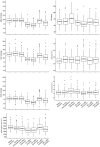Mechanisms contributing to hypotension after anesthetic induction with sufentanil, propofol, and rocuronium: a prospective observational study
- PMID: 33523352
- PMCID: PMC9122881
- DOI: 10.1007/s10877-021-00653-9
Mechanisms contributing to hypotension after anesthetic induction with sufentanil, propofol, and rocuronium: a prospective observational study
Abstract
It remains unclear whether reduced myocardial contractility, venous dilation with decreased venous return, or arterial dilation with reduced systemic vascular resistance contribute most to hypotension after induction of general anesthesia. We sought to assess the relative contribution of various hemodynamic mechanisms to hypotension after induction of general anesthesia with sufentanil, propofol, and rocuronium. In this prospective observational study, we continuously recorded hemodynamic variables during anesthetic induction using a finger-cuff method in 92 non-cardiac surgery patients. After sufentanil administration, there was no clinically important change in arterial pressure, but heart rate increased from baseline by 11 (99.89% confidence interval: 7 to 16) bpm (P < 0.001). After administration of propofol, mean arterial pressure decreased by 23 (17 to 28) mmHg and systemic vascular resistance index decreased by 565 (419 to 712) dyn*s*cm-5*m2 (P values < 0.001). Mean arterial pressure was < 65 mmHg in 27 patients (29%). After propofol administration, heart rate returned to baseline, and stroke volume index and cardiac index remained stable. After tracheal intubation, there were no clinically important differences compared to baseline in heart rate, stroke volume index, and cardiac index, but arterial pressure and systemic vascular resistance index remained markedly decreased. Anesthetic induction with sufentanil, propofol, and rocuronium reduced arterial pressure and systemic vascular resistance index. Heart rate, stroke volume index, and cardiac index remained stable. Post-induction hypotension therefore appears to result from arterial dilation with reduced systemic vascular resistance rather than venous dilation or reduced myocardial contractility.
Keywords: Blood pressure; Cardiac output; Cardiovascular dynamics; Hemodynamic monitoring; Intraoperative hypotension.
© 2021. The Author(s).
Conflict of interest statement
Bernd Saugel has received institutional restricted research grants, honoraria for giving lectures, and refunds of travel expenses from CNSystems Medizintechnik GmbH (Graz, Austria). Bernd Saugel has received honoraria for consulting, honoraria for giving lectures, and refunds of travel expenses from Edwards Lifesciences Inc. (Irvine, CA, USA). Bernd Saugel has received honoraria for consulting, institutional restricted research grants, honoraria for giving lectures, and refunds of travel expenses from Pulsion Medical Systems SE (Feldkirchen, Germany). Bernd Saugel has received institutional restricted research grants from Retia Medical LLC. (Valhalla, NY, USA). Bernd Saugel has received honoraria for giving lectures from Philips Medizin Systeme Böblingen GmbH (Böblingen, Germany). Bernd Saugel has received honoraria for consulting, institutional restricted research grants, and refunds of travel expenses from Tensys Medical Inc. (San Diego, CA, USA). Daniel I. Sessler is a consultant for Edwards Lifesciences Inc and Sensifree (Cupertino, CA, USA). The Department of Outcomes Research conducts research funded by Edwards Lifesciences Inc.. All other authors have no conflicts of interest.
Figures


References
-
- Walsh M, Devereaux PJ, Garg AX, Kurz A, Turan A, Rodseth RN, Cywinski J, Thabane L, Sessler DI. Relationship between intraoperative mean arterial pressure and clinical outcomes after noncardiac surgery: toward an empirical definition of hypotension. Anesthesiology. 2013;119:507–515. doi: 10.1097/ALN.0b013e3182a10e26. - DOI - PubMed
-
- Salmasi V, Maheshwari K, Yang D, Mascha EJ, Singh A, Sessler DI, Kurz A. Relationship between intraoperative hypotension, defined by either reduction from baseline or absolute thresholds, and acute kidney and myocardial injury after noncardiac surgery: a retrospective cohort analysis. Anesthesiology. 2017;126:47–65. doi: 10.1097/ALN.0000000000001432. - DOI - PubMed
Publication types
MeSH terms
Substances
LinkOut - more resources
Full Text Sources
Other Literature Sources
Medical

